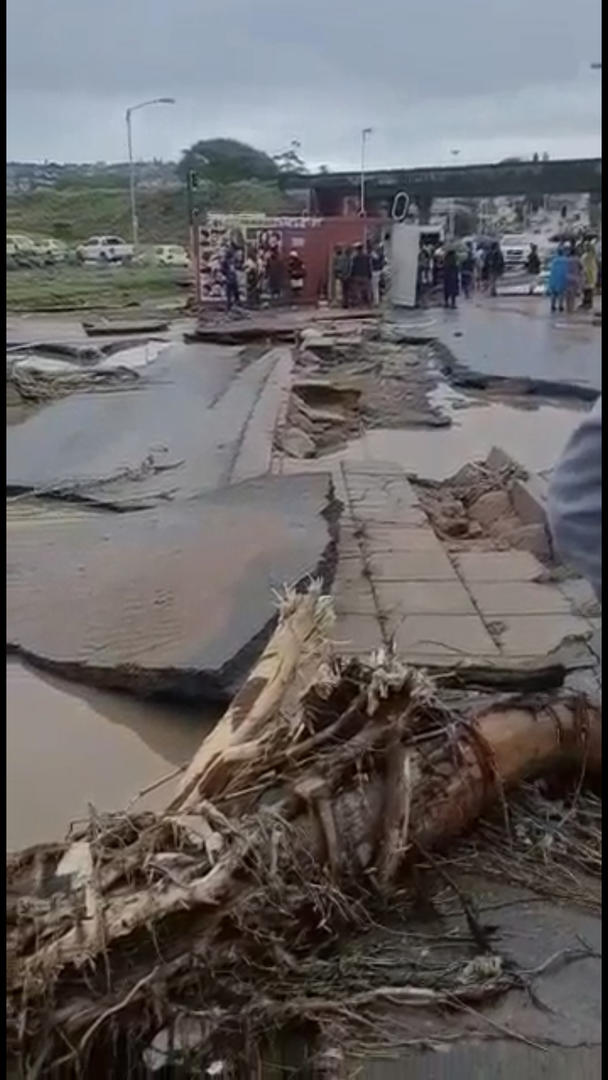
Flood damage in Reservoir Hills, Durban
There’s a quote from one of my favourite books : “When I have water, I must drink wine; but when I have no water, I must drink water.”
I arrived in my home town, Durban, Tuesday night, 12 April. Earlier in the day, eight weather stations in KwaZulu-Natal recorded new highs for rainfall.
By the time I got to my cousin’s home, the water supply was already out.
Umgeni Water, which provides most of the drinking water to the province, said heavy rains over the previous four days had caused substantial damage to raw water abstraction and conveyance infrastructure in at least three regions.
- Two aqueducts, which convey raw water to the Durban Heights Water Treatment Works, broke through rock falls in the vicinity of Inanda. These aqueducts have since been taken out of use due to the risk they pose to property and people.
- The river abstraction system in Mtwalume River was not functioning because of blockage caused by the flooded river.
- Abstraction from the Umzinto River Dam had reduced significantly due to high overflows, resulting in only 60% of potable water that is required being produced at the Umzinto Water Treatment.
- In iLembe, potable water production at the Lower Thukela Bulk Water Supply Scheme has been reduced because of high turbidity in raw water and abstraction pumps continue to fail as a result of silt in the abstraction channels. As a consequence of this, supply to KwaDukuza Central Business District, Darnall, Zamani and Zinkwazi has been interrupted.
- Umgeni Water’s customers include eThekwini Metro, Ugu District Municipality and iLembe District Municipality. With outflow slashed, Umgeni Water took to rationing available supplies among the three players supplying each of them in turn for 5 hour intervals.
- This meant that over the following days, eThekwini Metro would only receive 5 hours of water at a time every 15 hours. This water in turn, would need to be rationed among the various suburbs of the metro.
I’m giving you this information to give you a sense of the shitstorm that KZN is facing right now. Coleridge’s “water, water everywhere, and not a drop to drink” finally makes sense to me.
I went looking for drinking water to buy, as did my cousin. Almost every supermarket we went to was sold out of the 5 litre packs. Those that still had some were rationing these, two units per customer.
Soon, the local WhatsApp groups around Durban began pinging. “I have drinking water: R60 for 5 litres” immediately sparked outrage. Then came a report that one outlet was charging R36.99 for 500ml. “Corporate greed!” someone said.
There’s a lesson that I learned in Economics 101 at Princeton 30 plus years ago
If the demand for a product rises suddenly, and there is a finite supply of the product available, either the price has to increase or the supply dries up.
I bought a 4 pack of 5 litre Aquelle spring water at a gas station at a 50 percent markup on what I would normally pay. Would I have paid more? Absolutely. See opening paragraph.
High prices in times of need keep us honest. It mitigates against the inevitable scenario where some of us are buying up the available supply and profiteering (as in the WhatsApp group I mentioned).
Far better that more of us pay higher prices but still get access to the commodity rather than a few of us buy up the existing supply.
The cure for high prices is high prices: it incentivizes people to look for alternatives. That’s how we get innovation; and lower priced products in the long run.
